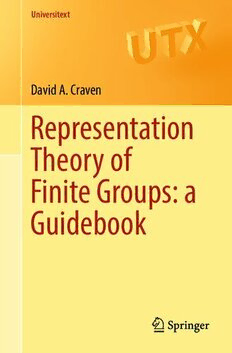
Representation Theory of Finite Groups: A Guidebook PDF
Preview Representation Theory of Finite Groups: A Guidebook
Universitext David A. Craven Representation Theory of Finite Groups: a Guidebook Universitext Universitext Serieseditors SheldonAxler SanFranciscoStateUniversity,SanFrancisco,USA CarlesCasacuberta UniversitatdeBarcelona,Barcelona,Spain AngusMacIntyre QueenMaryUniversityofLondon,London,UnitedKingdom KennethRibet UniversityofCalifornia,Berkeley,USA ClaudeSabbah Écolepolytechnique,CNRS,UniversitéParis-Saclay,Palaiseau,France EndreSüli UniversityofOxford,Oxford,UnitedKingdom WojborA.Woyczyn´ski CaseWesternReserveUniversity,Cleveland,USA Universitext is a series of textbooksthat presents material from a wide variety of mathematicaldisciplinesatmaster’slevelandbeyond.Thebooks,oftenwellclass- testedbytheirauthor,mayhaveaninformal,personalevenexperimentalapproach to their subject matter. Some of the most successful and established books in the series have evolved through several editions, always following the evolution of teachingcurricula,intoverypolishedtexts. Thus as research topics trickle down into graduate-level teaching, first textbooks writtenfornew,cutting-edgecoursesmaymaketheirwayintoUniversitext. Moreinformationaboutthisseriesathttp://www.springer.com/series/223 David A. Craven Representation Theory of Finite Groups: a Guidebook 123 DavidA.Craven SchoolofMathematics UniversityofBirmingham UnitedKingdom ISSN0172-5939 ISSN2191-6675 (electronic) Universitext ISBN978-3-030-21791-4 ISBN978-3-030-21792-1 (eBook) https://doi.org/10.1007/978-3-030-21792-1 MathematicsSubjectClassification(2010):20C20,20C15,20C30,20C33,20C08 ©SpringerNatureSwitzerlandAG2019 Thisworkissubjecttocopyright.AllrightsarereservedbythePublisher,whetherthewholeorpartof thematerialisconcerned,specificallytherightsoftranslation,reprinting,reuseofillustrations,recitation, broadcasting,reproductiononmicrofilmsorinanyotherphysicalway,andtransmissionorinformation storageandretrieval,electronicadaptation,computersoftware,orbysimilarordissimilarmethodology nowknownorhereafterdeveloped. Theuseofgeneraldescriptivenames,registerednames,trademarks,servicemarks,etc.inthispublication doesnotimply,evenintheabsenceofaspecificstatement,thatsuchnamesareexemptfromtherelevant protectivelawsandregulationsandthereforefreeforgeneraluse. Thepublisher,theauthors,andtheeditorsaresafetoassumethattheadviceandinformationinthisbook arebelievedtobetrueandaccurateatthedateofpublication.Neitherthepublishernortheauthorsor theeditorsgiveawarranty,expressorimplied,withrespecttothematerialcontainedhereinorforany errorsoromissionsthatmayhavebeenmade.Thepublisherremainsneutralwithregardtojurisdictional claimsinpublishedmapsandinstitutionalaffiliations. ThisSpringerimprintispublishedbytheregisteredcompanySpringerNatureSwitzerlandAG. Theregisteredcompanyaddressis:Gewerbestrasse11,6330Cham,Switzerland Preface The representation theory of finite groups has, at its core, a collection of open problems.Takentogether,theyarecalled‘local-globalconjectures’,although‘local- global rough guesses’ might be more appropriate. The missing pieces of the representation-theoreticpuzzle lie right in the centre, leaving us with corners and edgestofittogether. Many of the conjectures are numerical in nature, telling us that there is some exquisiteunderlyingstructuraltheory,butwecannotyetperceiveit.Thenumerical results are attractive in their own right, butit is the potentialhiddenstructure that makesthe subjectso captivating.Oneof themainpurposesofthistextisto make thisfieldaccessibletoanyonewithabasicunderstandingofrepresentationtheory, suchasthatprovidedbyanundergraduatecourseinit,andsomegeneralknowledge ofalgebra. Thelocal-globalconjecturesmightformthecentrepieceoffinitegrouprepresen- tationtheory,butthereismuchelseonthetablearoundthem:thetheoryofblocks withacyclicdefectgroup,therepresentationtheoryofthesymmetricgroups,and ofthegroupsofLietype,thestructureoftameblocks,andmuchmorebesides. The aim of this book is to give the reader a guided tour of these areas. Like a guide book, we seek to uncover the highlights of the field; proofs are more or less completely excised from this text, although the intrepid reader, using this as a springboard for further study, will be delighted to find that there are literally hundredsofreferencestoconsultformoredetails. Ofcourse,likeanyguidebook,itstartstobecomeoutofdateonceitiswritten. Thiswillsetinaspicthestate ofthetheoryattheearlypartof2019,butIbelieve thatmuchofthistheorywillremainrelevantfordecadestocome. Thefirstchapterquicklysummarizeswhatisneededaboutrepresentationtheory, andthesecondandthirdchaptersgothroughthebasicbuildingblocksofthetheory, namelythecharactertheoryandthemoduletheory. Theremainingchaptersaremoreorlessindependentofoneanother,thoughthere willbecrossreferencing.Thisshouldallowreaderstodipinandoutofthebookas andwhentheywanttoknowaboutaspecificaspectofthetheory. v vi Preface The local-global conjectures occupy Chap.4, the well-developed theory of blocks with cyclic defect groups following it in Chap.5. Chapter 6 attempts to givesomeroughideasaboutthestructureofblockswithnon-cyclicdefectgroups, althoughverylittleisknowninthiscase.ThenextchapterdealswithCliffordtheory, therelationshipbetweenmodulesforagroupandanormalsubgroup.Thelasttwo chapters give some of the representation theory of symmetric groups and of the groupsofLietype. Ialsohavetothankpeopleforhelpingfindsomeofthemanyerrorsthatoccurred in previous versions of this text. In particular, I thank David Benson, Norman McGregor, John Murray, Gabriel Navarro, Jeremy Rickard, Geoffrey Robinson, AdamThomas,MarkWildon,andespeciallyGunterMallefortheirsuggestions. Birmingham,UK DavidA.Craven Contents 1 TheBasics..................................................................... 1 1.1 RepresentationTheory.................................................. 1 1.2 GroupTheory ........................................................... 7 2 BlocksandTheirCharacters............................................... 15 2.1 BlocksandBlockIdempotents......................................... 17 2.2 BrauerCharacters....................................................... 19 2.3 Defect.................................................................... 28 2.4 BrauerCorrespondence................................................. 33 3 Modules ....................................................................... 37 3.1 Projectives............................................................... 38 3.2 Vertices,SourcesandtheGreenCorrespondence..................... 45 3.3 TheModuleCategory................................................... 53 3.4 Extensions............................................................... 61 3.5 TheStableandDerivedCategories..................................... 66 4 TheLocal-GlobalPrinciple................................................. 79 4.1 Brauer’sHeight-ZeroConjecture....................................... 80 4.2 TheMcKayConjecture................................................. 83 4.3 Alperin’sWeightConjecture ........................................... 87 4.4 Broué’sAbelianDefectGroupConjecture ............................ 89 4.5 Donovan’sConjecture .................................................. 94 4.6 Feit’sConjecture........................................................ 100 4.7 Brauer’sk(B)-Conjecture .............................................. 103 5 BlockswithCyclicDefectGroups.......................................... 107 5.1 TheBrauerTree......................................................... 107 5.2 BrauerTreeAlgebras................................................... 115 5.3 ClassificationofBrauerTrees.......................................... 124 5.3.1 FromAllGroupstoSimpleGroups ........................... 125 5.3.2 AlternatingGroups ............................................. 126 vii viii Contents 5.3.3 SporadicGroups................................................ 127 5.3.4 GroupsofLieType............................................. 128 6 BlockswithNon-cyclicDefectGroups..................................... 133 6.1 KleinFourDefectGroups.............................................. 134 6.2 TameDefectGroups.................................................... 137 6.3 NilpotentBlocks ........................................................ 146 6.4 WhatHappensinGeneral?............................................. 151 7 CliffordTheory............................................................... 153 7.1 RepresentationsandNormalSubgroups............................... 154 7.2 Group-GradedAlgebras ................................................ 158 7.3 ExtensionsofRepresentations.......................................... 160 7.4 CliffordTheoryofBlocks.............................................. 162 8 RepresentationsofSymmetricGroups.................................... 167 8.1 TheCombinatoricsoftheCharacterTable............................. 168 8.2 SpechtModules......................................................... 174 8.3 BlocksandDecompositionNumbersofSymmetricGroups.......... 186 8.4 TheDoubleCoverofS ................................................ 200 n 9 RepresentationsofGroupsofLieType.................................... 213 9.1 Defining-CharacteristicRepresentations............................... 214 9.2 UnipotentClassesandCharacters...................................... 225 9.3 UnipotentBlocks........................................................ 236 9.3.1 DistributionofUnipotentCharactersintoBlocks............. 237 9.3.2 BasicSets ....................................................... 239 9.3.3 UnitriangularityoftheDecompositionMatrix................ 242 9.3.4 ReductionModulopofCuspidalCharacters ................. 243 9.3.5 KnownDecompositionMatrices............................... 244 9.4 GeneralBlocks.......................................................... 247 References......................................................................... 257 IndexofNames................................................................... 279 Index............................................................................... 285 Chapter 1 The Basics Thisbookaimstointroducethereadertothemodernrepresentationtheoryoffinite groups.Todosoweneedsomeofthebasicsofrepresentationtheory,whichwewill ratherskimthrough,mostlytofixnotation.Wearegoingtoassumethatthereader ismoreorlessfamiliarwiththis,andmightneedarefresheronly.Wealsoinclude aratherrusheddescriptionofthegrouptheorywe willneedforthisbook,atleast to understandthe chaptersthat are not devoted to particular groups, most notably Chaps.4and9. 1.1 Representation Theory General references for the basic representation theory of finite groups include [313, 328, 388], although any textbook on representation theory or set of lecture notes from an advanced undergraduate/beginning graduate course will do. In particular, I personally have always found [328] an unparalleled first introduction torepresentationsoffinitegroups. Let k denote a field, which will have characteristic p (p is allowed to be 0). We will almost always consider k to be algebraically closed. A representation of a group G is a homomorphismG → GL (k). This is equivalentto the notion of n a (finite-dimensional) kG-module, which we define now. The group algebra kG of a group G over a field k is the k-algebra consisting of all formal finite linear combinationsofgroupelementswithcoefficientsink (sohasabasisconsistingof thegroupelements)andwithadditionandmultiplicationgivenbytheobviouslinear actions. A right kG-module is a right module for the group algebra kG. We can simply think of this as a vector space with an action of G on it. In this book, all of our modules will be rightmodules, and finite-dimensionalunless we explicitly mentionotherwise.Ofcourse,itisjustaconventiontouserightmodules,andallour theoremswillholdtrueforleftmodules,exceptperhapswithachangeofordering ©SpringerNatureSwitzerlandAG2019 1 D.A.Craven,RepresentationTheoryofFiniteGroups:aGuidebook,Universitext, https://doi.org/10.1007/978-3-030-21792-1_1
